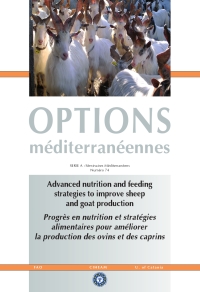| Article précédent | p. 95-99 | Article suivant |
Influence of feeding system on fatty acid composition of suckling lambs
The main objective of the present work was to determine ewe dietary treatment effects on intramuscular fatty acid composition of suckling lambs. Twenty-four pregnant Merinizzata Italiana ewes were divided into two groups of twelve each. One group was allowed to graze (grass group) and the other group was penned indoors and was fed hay ad libitum and commercial concentrate (stall group). After lambing, all ewes stayed with their respective lambs for the duration of the trial. The lambs were slaughtered at 100 days of age. Milk and lamb meat (longissimus dorsi muscle) fatty acids were analysed. The intramuscular fat of the grass group showed higher (P<0.001) proportions of polyunsaturated fatty acids (PUFA) than the stall group. The percentage of C12:0, C16:0 and C18:1 cis-9 were higher (P<0.05, P<0.001 and P<0.001) in the intramuscular fat of the stall group, whereas the grass group showed greater proportion of C18:3 (P<0.001). Moreover, eicosapentaenoic acid (C20:5 n-3) and docosapentaenoic acid (C22:5 n-3) were found in the highest amounts (P<0.001, P<0.01) in the meat of the grass group. PUFA/SFA ratio was higher (P<0.001) in the intramuscular fat of the grass group and n-6/n-3 ratio was lower (P<0.001) than the stall group. In contrast with previous work, this study has not found a significant difference in the proportion of C18:2 cis-9, trans-11 in the intramuscular fat within the two groups. This could be attributed to the poor condition of the pasture in the final phase of the trial and, mainly, to the young age of the lambs. This study confirmed that pasture enhanced the unsaturated fatty acid profile of intramuscular fat in lambs including omega-3 fatty acids.
L'objectif principal du présent travail était de déterminer les effets du traitement alimentaire des brebis sur la composition intramusculaire en acides gras d'agneaux allaitants. Vingt-quatre brebis Merinizzata Italiana en gestation ont été divisées en deux groupes de douze. Un groupe pouvait pâturer (groupe à l'herbage) et l'autre groupe était en stabulation et recevait du foin à volonté et un concentré commercial (groupe en stabulation). Après l'agnelage, toutes les brebis restaient avec leurs agneaux respectifs pendant la durée de l'essai. Les agneaux étaient abattus à l'âge de 100 jours. Les acides gras du lait et de la viande d'agneau (muscle longissimus dorsi) étaient analysés. Le gras intramusculaire du groupe à l'herbage montrait des proportions supérieures (P<0,001) d'acides gras poly-insaturés (PUFA) par rapport au groupe en stabulation. Le pourcentage de C12:0, C16:0 et C18:1 cis-9 était supérieur (P<0,05, P<0,001 et P<0,001) dans le gras intramusculaire du groupe en stabulation, tandis que le groupe à l'herbage montrait une plus grande proportion de C18:3 (P<0,001). De plus, l'acide eicosapentaénoïque (C20:5 n-3) et l'acide docosapentaénoïque (C22:5 n-3) étaient en plus grande quantité (P<0,001, P<0,01) dans la viande du groupe à l'herbage. Le rapport PUFA/SFA était supérieur (P<0,001) dans le gras intramusculaire du groupe à l'herbage et le rapport n-6/n-3 était inférieur (P<0,001) comparé au groupe en stabulation. En contrast avec l'étude précédente, ce travail n'a pas trouvé de différence significative dans la proportion de C18:2 cis-9, trans-11 dans le gras intramusculaire chez les deux groupes. Ceci pourrait être attribué au mauvais état du pâturage pendant la phase finale de l'essai et, principalement, au jeune âge des agneaux. Cette étude confirme que le pâturage augmente le profil en acides gras insaturés du gras intramusculaire chez les agneaux y compris les acides gras omega-3.
- [ Afficher ]
- [ Télécharger ]
- [ Exporter la citation ]
Vous pouvez télécharger la citation au format :
- [ Imprimer ]
-
Mots-clés
ACIDE GRAS, ALIMENTATION DES ANIMAUX, BREBIS, EXPERIMENTATION, LAIT, REGIME ALIMENTAIRE, VIANDE D'AGNEAUCiter cet article
Caparra P., Foti F., Scerra M., Cilione C., Vottari G., Galofaro V., Sinatra M.C., Scerra V. Influence of feeding system on fatty acid composition of suckling lambs. In : Priolo A. (ed.), Biondi L. (ed.), Ben Salem H. (ed.), Morand-Fehr P. (ed.). Advanced nutrition and feeding strategies to improve sheep and goat . Zaragoza : CIHEAM, 2007. p. 95-99. (Options Méditerranéennes : Série A. Séminaires Méditerranéens; n. 74). 11. Seminar of the FAO-CIHEAM Sub-Network on Sheep and Goat Nutrition, 2005/09/08-10, Catania (Italy). http://om.ciheam.org/om/pdf/a74/00800361.pdf



